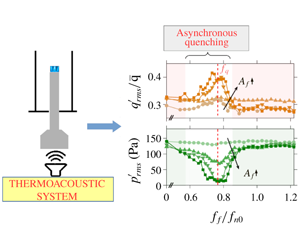Crossref Citations
This article has been cited by the following publications. This list is generated based on data provided by
Crossref.
Sujith, R. I.
and
Unni, Vishnu R.
2020.
Complex system approach to investigate and mitigate thermoacoustic instability in turbulent combustors.
Physics of Fluids,
Vol. 32,
Issue. 6,
Sujith, R. I.
and
Pawar, Samadhan A.
2021.
Thermoacoustic Instability.
p.
223.
Sujith, R. I.
and
Pawar, Samadhan A.
2021.
Thermoacoustic Instability.
p.
387.
Sahay, Ankit
Roy, Amitesh
Pawar, Samadhan A.
and
Sujith, R.I.
2021.
Dynamics of Coupled Thermoacoustic Oscillators Under Asymmetric Forcing.
Physical Review Applied,
Vol. 15,
Issue. 4,
Yang, Yao
Wang, Gaofeng
Fang, Yuanqi
Jin, Tai
and
Li, Jingxuan
2021.
Experimental study of the effect of outlet boundary on combustion instabilities in premixed swirling flames.
Physics of Fluids,
Vol. 33,
Issue. 2,
p.
027106.
Premraj, D.
Manoj, Krishna
Pawar, Samadhan A.
and
Sujith, R. I.
2021.
Effect of amplitude and frequency of limit cycle oscillators on their coupled and forced dynamics.
Nonlinear Dynamics,
Vol. 103,
Issue. 2,
p.
1439.
Lyu, Zengyi
Fang, Yuanqi
Zhu, Zhixin
Jia, Xiaowei
Gao, Xianzhi
and
Wang, Gaofeng
2022.
Prediction of acoustic pressure of the annular combustor using stacked long short-term memory network.
Physics of Fluids,
Vol. 34,
Issue. 5,
Manoj, Krishna
Pawar, Samadhan A.
Kurths, Jürgen
and
Sujith, R. I.
2022.
Rijke tube: A nonlinear oscillator.
Chaos: An Interdisciplinary Journal of Nonlinear Science,
Vol. 32,
Issue. 7,
Ghosh Mazumder, Arnab
Saha, Ritabrata
Mondal, Sirshendu
Ghosh, Koushik
Mukhopadhyay, Achintya
and
Sen, Swarnendu
2022.
Dynamics of a single-phase natural circulation system under harmonic excitation.
Chaos: An Interdisciplinary Journal of Nonlinear Science,
Vol. 32,
Issue. 12,
Mangodeh, F. Gh.
and
Tahsini, A. M.
2022.
OPERATING PRESSURE IMPACT ON THE FLAME RESPONSE IN TURBO ENGINE COMBUSTORS.
Journal of Applied Mechanics and Technical Physics,
Vol. 63,
Issue. 6,
p.
931.
Skene, Calum S.
and
Taira, Kunihiko
2022.
Phase-reduction analysis of periodic thermoacoustic oscillations in a Rijke tube.
Journal of Fluid Mechanics,
Vol. 933,
Issue. ,
Hu, Lulu
Yang, Peng
Lei, Xiangshu
and
Liu, Yingwen
2022.
Numerical investigation on oscillations characteristics of self-excited thermoacoustic system forced by acoustic wave.
Applied Energy,
Vol. 315,
Issue. ,
p.
119028.
Kushwaha, Abhijit K.
Worth, Nicholas A.
Dawson, James R.
Gupta, Vikrant
and
Li, Larry K.B.
2022.
Asynchronous and synchronous quenching of a globally unstable jet via axisymmetry breaking.
Journal of Fluid Mechanics,
Vol. 937,
Issue. ,
Singh, Samarjeet
Kumar Dutta, Ankit
Dhadphale, Jayesh M.
Roy, Amitesh
Sujith, R. I.
and
Chaudhuri, Swetaprovo
2023.
Mean-field model of synchronization for open-loop, swirl controlled thermoacoustic system.
Chaos: An Interdisciplinary Journal of Nonlinear Science,
Vol. 33,
Issue. 4,
2023.
Precursor detection of thermoacoustic instability using statistical complexity and artificial neural network.
Physics of Fluids,
Vol. 35,
Issue. 6,
Wen, Jing
Zhang, Lingxiao
Kang, Huifang
Liu, Shuli
and
Wang, Kai
2024.
Advances in the utilization and suppression of thermoacoustic effect: A review.
International Journal of Heat and Mass Transfer,
Vol. 231,
Issue. ,
p.
125758.
Yin, Bo
Yang, Zhijian
Guan, Yu
Redonnet, Stephane
Gupta, Vikrant
and
Li, Larry K. B.
2024.
Genetic programing control of self-excited thermoacoustic oscillations.
Physics of Fluids,
Vol. 36,
Issue. 6,
Wang, Pengcheng
Tian, Yu
Yang, Lijun
Luo, Sai
Li, Jingxuan
and
Liu, Tengyu
2024.
Open-loop control of thermoacoustic instabilities by the external acoustic forcing at different frequencies.
Proceedings of the Combustion Institute,
Vol. 40,
Issue. 1-4,
p.
105540.
Liao, Yu
Jin, Bingning
Yang, Siying
Li, Jiacheng
Liu, Peijin
and
Guan, Yu
2025.
Experimental investigation of solid propellants combustion response to pressure oscillations using advanced high-resolution diagnostics.
Applied Energy,
Vol. 377,
Issue. ,
p.
124227.
Zheng, Liheng
Liao, Yu
Kim, Kyu Tae
Zhou, Jie
and
Guan, Yu
2025.
Amplitude death in ring-coupled network with asymmetric thermoacoustic oscillators and nonlocal time-delay interactions.
Nonlinear Dynamics,
Vol. 113,
Issue. 7,
p.
6141.
